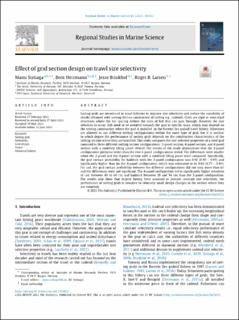| dc.contributor.author | Sistiaga, Manu | |
| dc.contributor.author | Herrmann, Bent | |
| dc.contributor.author | Brinkhof, Jesse | |
| dc.contributor.author | Larsen, Roger B. | |
| dc.date.accessioned | 2023-08-10T13:49:45Z | |
| dc.date.available | 2023-08-10T13:49:45Z | |
| dc.date.created | 2023-06-26T09:55:30Z | |
| dc.date.issued | 2023 | |
| dc.identifier.citation | Regional Studies in Marine Science. 2023, 63 . | en_US |
| dc.identifier.issn | 2352-4855 | |
| dc.identifier.uri | https://hdl.handle.net/11250/3083412 | |
| dc.description.abstract | Sorting grids are introduced in trawl fisheries to improve size selectivity and reduce the variability of results obtained with sorting devices constructed of netting e.g., codends. Grids are rigid or semi-rigid structures where the bar spacing defines the sizes of fish that can pass through. However, for size selection to occur, fish need to be oriented towards the grid in specific ways, which may depend on the netting construction where the grid is installed. In the Barents Sea gadoid trawl fishery, fishermen are allowed to use different netting configurations within the same type of grid, but it is unclear to which degree the performance of sorting grids depends on the construction characteristics of the netting section where they are installed. This study compares the size selective properties of a steel grid mounted in three different netting section configurations: 2-panel section, 4-panel section, and 4-panel section with a modified lifting panel. Overall, the results of the study demonstrate that the 2-panel configuration performs better than the two 4-panel configurations tested. The differences were smaller when the 2-panel and the 4-panel section with a modified lifting panel were compared. Specifically, the grid contact probability for haddock with the 2-panel configuration was 0.92 (0.90 – 0.95) and significantly higher than for the 4-panel configuration, which was estimated to be 0.82 (0.77 – 0.89). For cod, the grid contact probability between the different configurations did not vary more than 6% and the differences were not significant. The 4-panel configuration led to significantly higher retention of cod between 40 to 60 cm and haddock between 20 and 54 cm than the 2-panel configuration. The results also show that despite having been assumed to provide constant size selectivity, the performance of sorting grids is sensitive to relatively small design changes in the section where they are mounted. | en_US |
| dc.language.iso | eng | en_US |
| dc.publisher | Elsevier | en_US |
| dc.rights | Navngivelse 4.0 Internasjonal | * |
| dc.rights.uri | http://creativecommons.org/licenses/by/4.0/deed.no | * |
| dc.subject | Sorting grid | en_US |
| dc.subject | Selectivity | en_US |
| dc.subject | Grid design | en_US |
| dc.subject | Trawl | en_US |
| dc.subject | Demersal fishery | en_US |
| dc.title | Effect of grid section design on trawl size selectivity | en_US |
| dc.title.alternative | Effect of grid section design on trawl size selectivity | en_US |
| dc.type | Journal article | en_US |
| dc.type | Peer reviewed | en_US |
| dc.description.version | publishedVersion | en_US |
| dc.rights.holder | © 2023 The Author(s). Published by Elsevier Ltd. This is an open access article under the CC BY license (http://creativecommons.org/licenses/by/4.0/). | en_US |
| dc.source.pagenumber | 0 | en_US |
| dc.source.volume | 63 | en_US |
| dc.source.journal | Regional Studies in Marine Science | en_US |
| dc.identifier.doi | 10.1016/j.rsma.2023.103023 | |
| dc.identifier.cristin | 2157804 | |
| cristin.ispublished | true | |
| cristin.fulltext | original | |
| cristin.qualitycode | 1 | |

